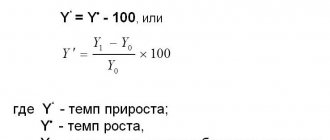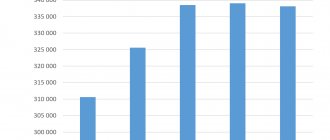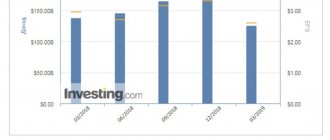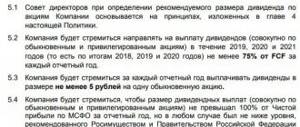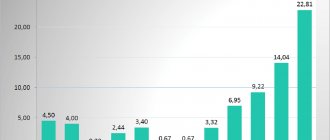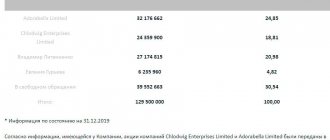When are Polymetal's dividends?
History of Dividend Payments
| Dividend type | Registry closing date | Volume, US$M |
| Final dividends for 2021 | May 7, 2021 | 419 |
| Interim dividends for 2021 | September 04, 2021 | 189 |
| Final dividends for 2021 | May 11, 2021 | 197 |
| Special dividends for 2021 | 14 Feb 2021 | 94 |
The future of FGC UES
At the AGM on May 15, shareholders approved the decision of the Board of Directors to transfer the powers of the sole executive body to the management organization Rosseti.
The powers of the current Chairman of the Board Andrei Murov were terminated ahead of schedule. At the same time, he joined the new board of directors, but with the rights of an “ordinary” director (so to speak).
What does this mean in practice? According to the FGC UES website, “the transfer of management to Rosseti should increase the efficiency of the group of companies and reduce costs.” The presence of a single executive body will allow all cash flows to be “closed” to the parent company. For a long time now, most of Rosseti’s profits have been generated by the cash flows of FGC UES. So the step to actually consolidate the two companies is quite logical.
But what does this mean for the future?
Since 2014, Rosseti has been trying to combine the assets of all its subsidiaries and create on their basis a single mega-company, the largest Russian and global energy company. This would allow optimizing operating costs and increasing the overall profit of the entire group.
In January 2021, the head of Rosseti, Andrei Livinsky, received Vladimir Putin’s consent to consolidate FSK on the basis of Rosseti. After consolidation, the formation of a common treasury may follow according to one of two schemes:
- delisting of shares of Rosseti and FGC UES with the simultaneous issue of shares of the new merged company and the conversion of shares of old companies into them;
- forced repurchase of FGC UES shares from minority shareholders and delisting of FGC UES.
And here’s another interesting article: MTS dividends in 2021: no change on the telecom front
To implement the first plan, the consent of the FAS and the main shareholders is required, for the second - ownership of a package of 95% of the total number of shares (Rosseti now has a little more than 80%).
Everything may remain as before; another question is for how long. It seems that Rosseti seriously intends to unite all its subsidiaries and become a real significant blue chip on the Moscow Exchange. But it is unclear what scheme they will follow.
Let me remind you that Rosseti itself is paying record dividends this year - 18.9 kopecks per preferred share and 8.85 kopecks per ordinary share, which gives a dividend yield of 9.81% and 6.81%, respectively (at current quotes).
Thus, FGC UES remains one of the most profitable subsidiaries of Rosseti in terms of dividends. The company pays generous dividends in 2021 and provides an impressive yield against the background of falling payments from other companies. But the shares of FGC UES are not liquid enough and the sword of Damocles hangs over them in the form of possible delisting or exchange for shares of a new company.
So I think that in conditions of such uncertainty, after the payment of dividends, we will see a downward trend in shares and active purchase of large blocks of securities from minority shareholders by the parent company. What do you think about FGC UES? Write in the comments! Good luck, and may the dividends be with you!
Rate this article
[Total votes: Average rating: ]
Dividend policy
The company takes as its basis strict observance of all shareholder rights. They are provided for in the legislation of the Russian Federation. The Federal Grid Company pursues a policy that coincides with the views of its parent Rosseti.
Now 50% of net profit will be used for payments, which is adjusted according to IFRS or RAS. Analysts say returns in 2021 will be 9%.
This is a good indicator of reporting, but the main indicator is a change in the dividend payment policy. The strategy is expected to change and update. Rosseti is recommended to pay up to 5 billion rubles for the 1st quarter of 2021.
The attractive valuation of FGC UES implies 2.9x 2019E EV/EBITDA with a 17% discount to Rosseti shares (3.5x). This is a more interesting dividend bet compared to the parent company.
When to buy?
Above, we offered our view of the “ideal” portfolio of dividend-paying Russian stocks for the next decade. We tried to select companies from different industries and with different business models, so that when certain events occur, at least one of them would be in an advantageous position, compensating for the decline in the financial performance of other companies in the portfolio. But the important question remains, when to buy shares? From the point of view of an investment time horizon of 10 years, the entry price may not be the most important parameter of future profitability. However, in our opinion, the best solution would be to gradually fill the portfolio during periods of drawdown in individual stock prices.
We, the Investland team - independent investment advisors - are ready to help you understand the complex world of financial assets. If you have any questions regarding investments, incl. in dividend shares, contact us. Our experienced consultants will definitely help you with quality advice!
Happy investment!
Brief description of the issuer
FGC UES is the operator of the Unified National (All-Russian) Electric Network (UNEG), providing 50% of the country's energy consumption. The length of power lines is 145.9 thousand km, transformer capacity is 351.9 GVA.
Capital structure . The controlling stake, 80.13%, belongs to the state company Rosseti. The Federal Property Management Agency holds 0.59% of the shares. The company has issued ordinary shares and GDRs with a listing on the London Stock Exchange. Free-float of ordinary shares 21%.
Stock growth is not over yet
We wrote earlier that the profitability of shares is formed from two components - dividend payments and the increase in their market value. There is a certain connection at a fundamental level between market value and dividend yield. Unfortunately, it is not linear, but it can serve as a kind of guideline when predicting quotes. The logic works like this: if there are two identical assets with the same value but different dividend yields, investors will prefer the asset with the higher yield by buying it, which will cause its value to rise. The growth in quotes will continue until dividend yields are equal. For example, shares cost 100 rubles and bring 8 rubles. dividends, i.e. their yield is 8%. Similar shares cost 50 rubles. and bring 5 rubles. dividends, yield 10%. To equal this indicator, shares must rise from 50 rubles. up to 62.5 rub. or by 25%. Of course, the entire logic of such reasoning is based on the absolute identity of companies, which actually does not exist. However, some approximate guidelines can be obtained.
At the current time, the Russian market offers international investors the most attractive dividend yield among world markets - about 7.5% per annum. Countries such as Brazil and Turkey, with which analysts often compare our market, have a similar figure - 4% and 5%, respectively. There are many external factors that prevent direct comparison. But if we imagine that international investors suddenly began to perceive the risks of investing in Russian shares at the level of Brazilian or Turkish ones, according to the logic of the previous paragraph, stock quotes of domestic joint stock companies should quickly grow by at least 50% from current levels! At the same time, there is every reason to assume that the growth may be greater, because Dividend payments are constantly growing, and, consequently, dividend yield is also growing. The key question is what needs to happen for the Russian stock market to be revalued by global investors. Perhaps such a trigger will be the lifting of sanctions or some other events that we cannot predict at the current time.
Dividend shares 10 years ago
The graph comparing the two indices clearly shows that the divergence in their dynamics began around 2014-2015. The reason for the discrepancy began was several factors, which we will discuss below. We selected 22 liquid stocks that are currently considered to have a good dividend history, or had one at the beginning of the decade, to track the evolution of dividends in Russia. If the company has preferred shares, they were included in the sample, because they provide higher dividend yields. You can find a table with their name, total dividends, increase in market value, as well as profitability for this period below. But first, let’s imagine what the Russian market was like a decade earlier.
After the devastating year of 2008, the market was still dominated by ideas about the intrinsic or fair value of shares calculated using the DCF (discounted cash flow) model. Dividends were perceived as a pleasant bonus. Corporations did not care much about this indicator, often without a clear dividend policy and paying dividends once a year. The average dividend yield of 17 of the 22 selected stocks was 3% per annum. Another 5 companies did not pay dividends at all.
Important news and valuable ideas
Subscribe to our Telegram channel we are on Telegram
The organization makes the decision to pay or not pay a dividend based on its internal need for financial resources. If there is an investment project with high potential, the funds remaining in the form of profit are more likely to be invested in it. This was the picture observed in the electricity sector at the beginning of the decade. All profits went to the modernization of old and construction of new facilities, in accordance with previously adopted investment programs. Another example of such a policy is Gazprom, which until recently implemented capital-intensive projects to transport gas to Europe and China, which is why its dividend yield until 2021 was at the level of 4-5% per annum.
Another reason why shareholders may be left without dividends is the company's desire to maintain a safety net in the form of cash in case of a repeat crisis. The fear of a repeat of 2008 was quite high at the beginning of the decade, so many market players, for example, Severstal and NLMK, preferred to preserve cash assets, paying significantly less for dividends than they could. Their dividend yields were 1.7% and 0.9%, respectively. Surgutneftegaz still adheres to this policy, having accumulated more than $52 billion in its accounts, which is 2.5 times more than its current capitalization!
Dividends are an important part of profitability
In order to understand what contribution dividends have made to the overall return of Russian stocks over the past decade, we compared two ruble indices - the standard MICEX index (IMOEX) and the MICEX total return index (MCFTR), which includes dividends on shares included in the index. We took January 11, 2010 as our starting point to exclude the rapid growth of 2009, when the stock market doubled after falling in 2008. The results were very revealing.
| Index | Value as of 01/01/2010 | Value as of 09/15/2019 | Absolute increase, % | Average annual profitability, %* |
| IMOEX | 1370,01 | 2791,74 | 104% | 7,6% |
| MCFTR | 1474,41 | 4656,02 | 216% | 12,6% |
| IFX-Cbonds | 264,01 | 630,72 | 139% | 9,4% |
* Compound interest
In less than 10 years, the market value of Russian shares increased by 104%, while their yield, taking into account dividends, amounted to 216% in absolute value, or an average of 7.6% and 12.6% per annum, taking into account reinvestment, respectively. For comparison, a similar indicator of the IFX-Cbonds index, reflecting the total return on the portfolio of the 30 most liquid corporate bonds of domestic issuers, for the same period amounted to 9.4% per annum, and the average return on a one-year deposit was slightly more than 8% per annum.
Grade
In the comparative approach, we used 2 techniques: an assessment based on multiples relative to analogues, Russian and foreign, using a country discount of 30%, as well as an analysis of the value based on the target dividend yield.
The valuation based on multiples relative to peers implies a target price of RUB 0.328. per share, which is 54% higher than the current price.
The target dividend yield estimate assumes a target of RUB 0.215. with an average forecast payment for 2020–2022. RUB 0.0183 and a target return of 8.5%.
Combined target price: RUB 0.272. per share at the end of 2022 with a potential of 28% to the current price. Based on the high potential, we confirm our Buy recommendation for FGC UES shares.
| Company | P/E 2022E | EV/EBITDA 2022E |
| FGC UES | 3,3 | 3,2 |
| Rosseti Moscow region | 5,1 | 3,4 |
| IDGC of Center and Volga Region | 3,8 | 2,4 |
| Rosseti Siberia | 19,0 | 7,1 |
| Rosseti Volga | 4,7 | 2,4 |
| IDGC of Center | 4,1 | 3,1 |
| IDGC of Urals | 8,6 | 2,8 |
| IDGC of the North-West | NaN | 3,4 |
| Rosseti South | NaN | 7,0 |
| Rosseti Lenenergo JSC | 3,7 | 2,6 |
| Rosseti Northern Caucasus | NaN | NaN |
| Rosseti Kuban | 58,6 | 7,5 |
| shopping mall | 18,0 | 2,1 |
| Median, RU (weight 80%) | 5,1 | 3,1 |
| Median, EM (weight 10%) | 10,4 | 5,9 |
| Median, DM (weight 10%) | 16,6 | 10,6 |
| Indicators for assessment, billion rubles. | Net profit 2022E | EBITDA 2022E |
| 82 | 147 | |
| Target capitalization, billion rubles: | ||
| — RU | 417 | 259 |
| —EM | 595 | 470 |
| —DM | 944 | 954 |
| Weighted assessment of capitalization, billion rubles. | 419 | |
| For reference: net debt, minority share, billion rubles. | 197 |
Source: Reuters, estimates and calculations of FINAM Group of Companies
The weighted average target price for a sample of analysts with historical forecast performance for this stock of at least the average is, according to our calculations, RUB 0.246. (upside 16.0%), stock rating 3.3 (a rating value of 5.0 corresponds to a Strong Buy recommendation, and 1.0 corresponds to a Strong Sell).
Including the estimate of the target price for FGC UES shares by BCS analysts is 0.27 rubles. (recommendation - “Buy”), VTB Capital - 0.23 rubles. ("Buy").
